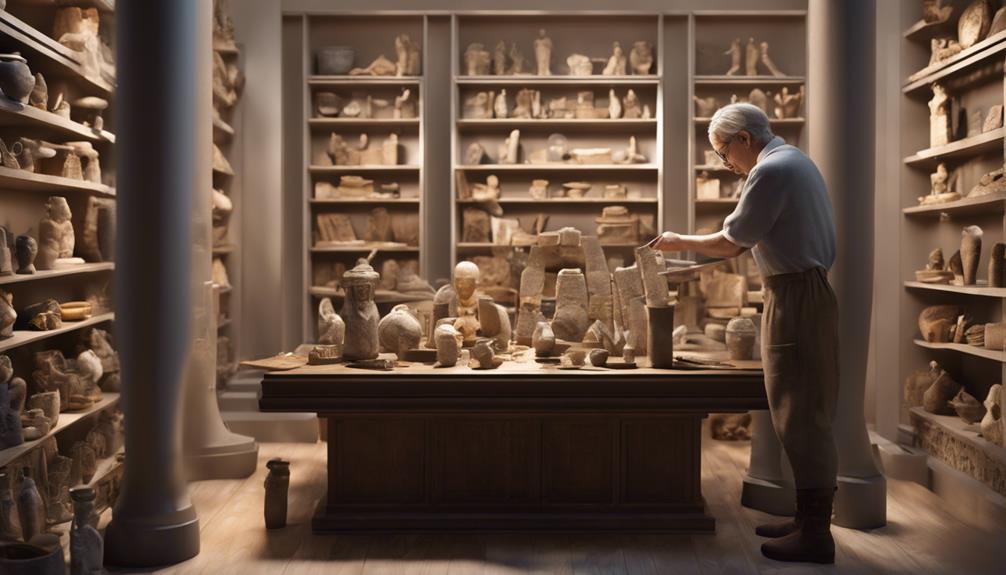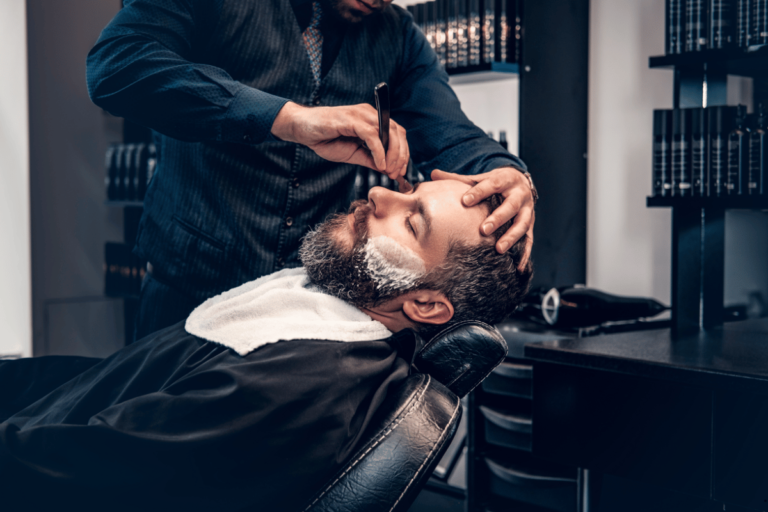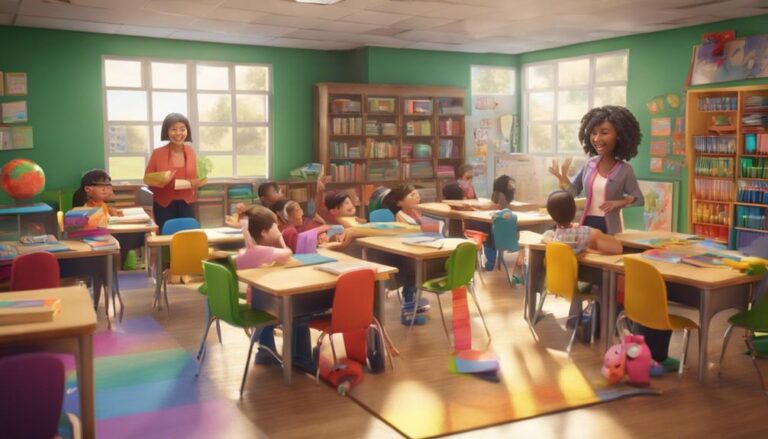Museum Curator Job Description
In the explore role of a museum curator, you carefully manage collections, plan exhibitions, and conduct research. Building relationships with donors and the community is crucial for financial sustainability. An advanced degree in Museum Studies or related fields is necessary, along with strong art history knowledge. Skills in exhibition curation, artifact preservation, and collaboration are essential. Career opportunities are growing, with an 11% projected job growth. Median annual wage is $59,130, varying by location and experience. Immerse yourself in the fascinating world of museum curation where creativity and meticulous detail intersect to bring history and art to life.
Key Takeaways
- Manage collections, plan exhibitions, conduct research, ensure financial sustainability, and build donor relationships.
- Advanced degree in Museum Studies or related field required for educational qualifications.
- Skills include art history knowledge, exhibition curation, collection management, teamwork, and project management.
- Responsibilities encompass inventory tracking, preservation, documentation, acquisitions, and record-keeping.
- Career outlook shows 11% job growth with median annual wage of $59,130, varying based on experience and education.
Responsibilities
When overseeing the responsibilities of a museum curator, it's essential to meticulously manage collections, plan exhibitions, and conduct research. Effective budget management is important to guarantee the financial sustainability of the museum. Curators are tasked with allocating funds for acquisitions, conservation, and exhibition development while adhering to financial constraints.
Public relations play an important role in a curator's responsibilities. Building relationships with donors, artists, and the local community is key to securing funding, loans, and collaborations. Engaging with the public through various platforms fosters a deeper appreciation for the museum's collections and programs.
Event planning is another critical aspect of a curator's role. Organizing exhibitions, lectures, workshops, and special events requires careful coordination and attention to detail. Implementing innovative marketing strategies to promote these events enhances outreach and attracts diverse audiences to the museum.
Educational Requirements
An advanced degree in a relevant field is typically required for individuals aspiring to become museum curators. Degree options for aspiring museum curators often include a Master's degree in Museum Studies, Art History, Anthropology, History, or a related field. These programs provide a thorough understanding of museum operations, collection management, exhibition design, and preservation techniques.
Professional development is vital for museum curators to stay current in their field. This can include attending conferences, workshops, and seminars related to museum practices and trends. Additionally, pursuing certifications such as the Certified Institutional Protection Manager (CIPM) or Certified Institutional Protection Specialist (CIPS) can enhance a curator's expertise in safeguarding museum collections.
Continuing education through online courses or specialized workshops can also be beneficial for museum curators looking to expand their knowledge and skills in areas such as digital curation, cultural heritage preservation, or grant writing. Overall, a strong educational background and a commitment to ongoing professional development are essential for a successful career as a museum curator.
Skills and Qualifications
As you explore the skills and qualifications needed for a Museum Curator role, you must consider the required qualifications and essential skills.
These aspects are vital in determining your suitability for this position and your ability to excel in the role.
Understanding the necessary qualifications and possessing the essential skills will be key to your success as a Museum Curator.
Required Qualifications
To be considered for a Museum Curator position, you must possess a strong background in art history, museum studies, or a related field. Experience in curating exhibitions, managing collections, and conducting research is essential. A proven track record of successfully organizing and implementing museum programs and events is also highly valued.
Training in archival methods, conservation techniques, and artifact handling is required for this role. Additionally, familiarity with museum database systems and cataloging practices is beneficial. A master's degree in art history, museum studies, or a related discipline is typically expected.
Strong communication skills, attention to detail, and the ability to work collaboratively with diverse teams are key attributes for a successful Museum Curator.
Essential Skills
Developing a diverse set of essential skills is important for excelling in the role of a Museum Curator. Strong team collaboration abilities are essential for working with colleagues, artists, and other professionals in the art community.
As a curator, you must possess exceptional project management skills to oversee exhibitions, budgets, and timelines effectively. Attention to detail is key when handling valuable artifacts and coordinating events.
Effective communication skills are necessary for engaging with visitors, donors, and scholars. Research proficiency is required for conducting in-depth studies on art collections. Adaptability and problem-solving skills are valuable when faced with unexpected challenges.
Collection Management
Efficiently organizing and cataloging the museum's acquisitions is an essential aspect of collection management. When it comes to overseeing the museum's collection, attention to detail and meticulous record-keeping are paramount. Here are three key elements to keep in mind:
- Inventory Tracking: Implementing a robust inventory tracking system is important for keeping tabs on every piece in the collection. This involves meticulously documenting each item's acquisition date, provenance, condition, and location within the museum.
- Preservation Techniques: Utilizing proper preservation techniques is essential for maintaining the integrity of the museum's artifacts. This includes controlling environmental factors such as temperature, humidity, and lighting to prevent deterioration.
- Documentation Management: Keeping detailed records of each item in the collection is necessary. This documentation should include thorough descriptions, photographs, and any historical or contextual information related to the artifact. Maintaining a well-organized database facilitates easy access to information and aids in research and exhibition planning.
Exhibition Curation
When curating exhibitions, you'll need to carefully consider the theme selection process to create a cohesive narrative that engages your audience.
Utilizing artwork arrangement techniques such as juxtaposition, sequencing, and spatial design will play an essential role in conveying your intended message effectively.
Theme Selection Process
To curate a successful exhibition, begin by meticulously analyzing potential themes to guarantee alignment with the museum's vision and audience preferences.
Start with theme brainstorming sessions involving the curatorial team to generate diverse and innovative ideas.
Consider the exhibit design elements such as layout, color schemes, and interactive components that will enhance the chosen theme.
Conduct audience research to understand their interests and make sure the theme resonates with visitors.
Artwork Arrangement Techniques
Explore various innovative artwork arrangement techniques to elevate the impact and visual storytelling of your exhibition curation. Spatial organization plays an essential role in creating a cohesive and engaging display.
Consider arranging artworks based on themes, colors, or styles to guide the viewer's journey through the exhibition. Establishing a visual hierarchy within the space can draw attention to key pieces and create a harmonious flow.
Experiment with different layouts, such as grid, salon-style, or chronological ordering, to enhance the viewer's experience. Utilize techniques like clustering related artworks or creating focal points to capture visitors' interest.
Research and Documentation
Engage in thorough research and meticulous documentation to enrich the museum's collection and guarantee accurate historical representation. When focusing on research and documentation as a museum curator, there are key aspects to take into account:
- Utilize Various Research Methods: Employ a range of research methodologies such as archival research, interviews with experts, and scientific analysis to enhance your understanding of the artifacts in the collection.
- Implement Preservation Techniques: Apply the latest preservation techniques to safeguard the longevity of the museum's artifacts. This includes proper storage conditions, handling procedures, and conservation treatments.
- Maintain Detailed Documentation: Keep detailed records of each artifact, including its provenance, condition reports, and any relevant historical information. This documentation not only aids in the curation process but also serves as a valuable resource for future research and exhibitions.
Collaboration and Networking
As you expand your role as a museum curator, forging collaborative relationships and building a robust network within the cultural sector becomes increasingly vital. Attending networking events and actively seeking out opportunities to connect with other professionals in the field won't only enhance your knowledge base but also open doors to potential collaborations. Engaging with colleagues, artists, historians, and other experts through these interactions can lead to exciting partnerships that benefit both your institution and the broader cultural community.
Building professional connections isn't just about exchanging business cards; it's about fostering meaningful relationships that can spark innovative projects and exhibitions. By cultivating a diverse network of contacts, you can tap into a wealth of expertise and resources that can elevate the impact of your curatorial work. Whether it's collaborating on a new exhibit, sharing research findings, or co-hosting events, the power of a strong network shouldn't be underestimated in the world of museum curation.
Career Outlook
In the evolving landscape of museum curation, understanding the career outlook is essential for strategic planning and professional development. When considering a career as a museum curator, here are three key points to keep in mind:
- Job Growth: The job outlook for museum curators is projected to grow by 11% from 2020 to 2030, which is faster than the average for all occupations. This growth is driven by the increasing public interest in cultural heritage and the need for museums to expand their collections.
- Salary Potential: The median annual wage for curators was $59,130 in May 2020. However, salaries can vary based on factors such as the size and location of the museum, as well as the curator's level of experience and education.
- Specialization Opportunities: As museums continue to diversify their collections and exhibitions, there's a growing demand for curators with specialized knowledge in areas such as contemporary art, digital media, or cultural anthropology. Developing expertise in a specific niche can enhance your career prospects and earning potential in this field.
Frequently Asked Questions
Are Museum Curators Responsible for Fundraising and Grant Writing?
Yes, as a museum curator, you are typically responsible for fundraising and grant writing. These tasks are essential for securing financial support to sustain exhibitions, acquisitions, and educational programs that enrich the museum's offerings.
How Do Museum Curators Ensure the Security of Valuable Artifacts?
In order to guarantee the security of valuable artifacts, you meticulously establish and enforce security protocols. Implementing advanced surveillance systems, monitoring artifacts round-the-clock, and restricting access are essential practices to safeguard priceless treasures within the museum's collection.
Do Museum Curators Have Opportunities for International Collaborations?
You, as a museum curator, have ample opportunities for international collaborations. Engage in cultural exchange, forge valuable connections, and expand your network globally. Benefit from diverse perspectives and enrich your work through collaborative projects.
What Software Tools Do Museum Curators Use for Collection Management?
To manage collections effectively, museum curators rely on digital cataloging software like TMS or PastPerfect. These tools streamline inventory, research, and preservation efforts. Online exhibitions can be curated using platforms such as Omeka or eMuseum.
Are Museum Curators Involved in Conservation and Restoration Projects?
Just like a skilled artisan restoring a masterpiece, museum curators are deeply involved in conservation techniques and restoration methods. They meticulously navigate preservation challenges and oversee intricate restoration processes to protect cultural treasures.
Conclusion
As a museum curator, you'll immerse yourself in the world of art and history. Carefully selecting and showcasing exhibits that captivate and educate visitors. Your passion for preserving cultural heritage will shine through as you collaborate with artists, historians, and other professionals to create unforgettable experiences.
The intricate dance of research, curation, and management will become second nature to you. Guiding you on a journey of discovery and creativity in the fascinating world of museum curation.







